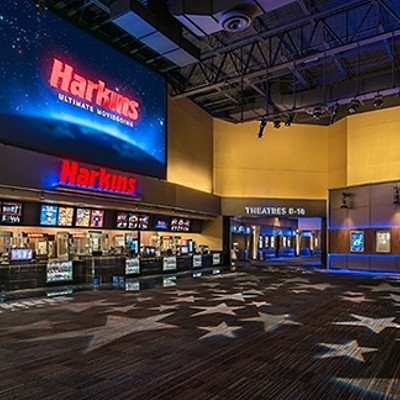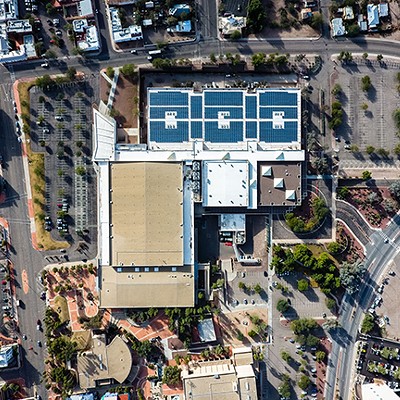While building swanky hotels and lunch counters throughout the southwest along the Santa Fe Railroad, the great travel impresario Fred Harvey noticed how fascinated people were with anything relating to the region's mysterious, seemingly unknowable indigenous people.
To capitalize on the public's fascination with cultures, Harvey hired as guides attractive, educated young women who knew their history, anthropology, ethnology and art. He then packed intrepid tourists who could pay--in 1936--about $45 per person into tough but comfortable limousines with a mess of gourmet box lunches, and drove them in style from the depot deep into Indian Country. These trips were famously called "Indian Detours"--three days of adventure and exoticism billed, according to surviving pamphlets, as "the most distinctive motor cruise service in the world ... off the beaten path in the Great Southwest."
While today's visitors to the Great Southwest are likely to choose a pink jeep tour to the harmonic vortexes of Sedona or a spa week at Canyon Ranch over a trip laden with too much history and local color, a movement is underway to increase the number of National Heritage Areas--in the Arizona, specifically, and the West in general--thus, perhaps, bringing back a bit of the exotic appeal the region once had before air conditioning and rust-belt migrations made this place pretty much just like every other place.
Indeed, identity is the key concept of the heritage-area philosophy.
The idea is to, in effect, brand a landscape, and to do so by first quantifying and then connecting a particular region's "stories." A federal designation realized by an act of Congress, a National Heritage Area is eligible for up to $1 million per year in federal matching funds for historic restoration, interpretation and marketing. The federal overlay does not affect private-property rights, and individuals within a Heritage Area can opt out if they so choose.
For a long time, the Heritage Area phenomenon was confined to the East, South and Midwest. Of the 37 active Heritage Areas in the nation, only four are in the West, and only one, the Yuma Crossing Heritage Area along the Lower Colorado, is in Arizona.
This may be about to change.
Late last month, the U.S. House of Representatives passed the Celebrating America's Heritage Act, legislation that would create several new heritage areas, including the local Santa Cruz Valley National Heritage Area. Running from Marana to the border and encompassing about 3,300 square miles, the area would celebrate, preserve and interpret the various cultures and histories that have grown along the now mostly dry Santa Cruz River over the last, say, 1,200 years--from the Hohokam to the Spanish; from the O'odham to the Gadsden Purchase. The Senate is considering the bill.
The concept "is growing in the West," said Eleanor Mahoney, program assistant with the National Parks Department's National Heritage Area program. "More and more communities are seeing this as a way to conserve cultural and natural resources."
In 2006 alone, three new heritage areas sprung up in the West--in Nevada, Utah and New Mexico. The Utah area, the National Mormon Pioneer Heritage Area, links dozens of rural communities in Southern Utah according to their shared Latter-day Saint traditions, creating a marketing and economic development template that brings in dollars from tourists interested in one of the most fascinating stories in the West, while at the same time assuring that those stories won't be forgotten.
"One feeds off the other," explained Vanessa Bechtol, programs manager with the Santa Cruz Valley Heritage Alliance, the nonprofit pushing for the local heritage area. "It's a way to stimulate economic growth while also preserving this area's traditions; in part, it's about balancing the two: By preserving these cultural traditions, natural landscapes and cultural sites, we are creating an authentic experience that will draw people."
Not everybody agrees that the heritage area concept is wholly innocuous. With the recent vote in Congress, private-property think tanks peppered the Internet with worries that a federal overlay on land that includes private property, no matter how easy-going, will turn all ugly and land-hungry--an historically Western stance that is today conservative dogma. While the rules governing heritage areas make it clear that the designation has no effect on private property, and a 2004 Government Accountability Office report confirmed this, opponents of the idea point to a recent controversy involving the Yuma Crossing National Heritage Area as proof that the program isn't as passive as it claims to be.
After the bill to create the Yuma Heritage Area passed in 2000, the Yuma County Farm Bureau sent out a letter to its members warning them that their private property could be under threat. That mobilized the area's farmers with fear, and hundreds chose to vociferously opt out of the designation. A few years later, Rep. Raul Grijalva--the same lawmaker responsible for introducing the recent legislation--got a bill through Congress that limited the boundaries of the Yuma Heritage Area, apparently mollifying the critics, but not before the heritage-area concept got a bit of bad press.
So far, the proposed Santa Cruz Valley National Heritage Area has no organized opposition, and some of its organizers are looking into creating another heritage area in Arizona that would bring the whole idea of heritage tourism full circle.
Bill Doelle, president of the Center for Desert Archeology and a Santa Cruz Valley Heritage Alliance board member, said that his group is working on getting the entire drainage area of the Little Colorado River, in northeastern Arizona, designated as a heritage area--from the railroad towns along Route 66 and the Santa Fe line, through the Painted Desert and the Petrified Forest, up to Hopi and Navajoland.
That is, of course, the same exotic outback region where Fred Harvey used to run his Indian Detours.
"So many folks that live here are newcomers," Doelle said. "Heritage areas serve a huge role in educating the citizenry and trying to help people gain a sense a place."












